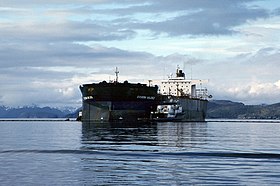
Back Exxon Valdez Afrikaans Exxon Valdez Catalan Exxon Valdez Czech Exxon Valdez Danish Exxon Valdez German Exxon Valdez English Exxon Valdez Esperanto Exxon Valdez Spanish Exxon Valdez Estonian Exxon Valdez Basque
| Exxon Valdez | |
 L’Exxon Valdez échoué. | |
| Autres noms | Exxon Mediterranean Sea River Mediterranean S/R Mediterranean Mediterranean Dong Fang Ocean Oriental Nicety |
|---|---|
| Type | pétrolier puis minéralier |
| Histoire | |
| Chantier naval | National Steel and Shipbuilding Company, San Diego |
| Quille posée | |
| Lancement | |
| Mise en service | |
| Statut | détruit en 2012 |
| Équipage | |
| Équipage | 21 |
| Caractéristiques techniques | |
| Longueur | 300 m |
| Maître-bau | 50 m |
| Tirant d'eau | 20 m |
| Déplacement | 214 862 t |
| Tonnage | 110 831 jb |
| Propulsion | Diesel lent, 1 hélice |
| Puissance | 23,6 MW |
| Vitesse | 16,25 nœuds |
| Caractéristiques commerciales | |
| Capacité | 235 000 m3 de brut |
| Carrière | |
| Propriétaire | Hong Kong Bloom Shipping Ltd (d) |
| Armateur | Exxon Shipping Company (1986–1989)
|
| Affréteur | International Marine Transportation Ltd. |
| Pavillon | Îles Marshall |
| Port d'attache | Philadelphie |
| Indicatif | V7HS3 |
| MMSI | 356270000 |
| IMO | 8414520 |
| modifier |
|
L’Exxon Valdez est un pétrolier américain qui s'échoua en 1989 sur la côte de l'Alaska et provoqua une importante marée noire. L'échouement de ce navire, alors propriété de Exxon Shipping Company, et ses conséquences environnementales eurent un grand retentissement aux États-Unis et entraînèrent des modifications significatives de la législation américaine sur le transport maritime, en particulier de pétrole.